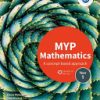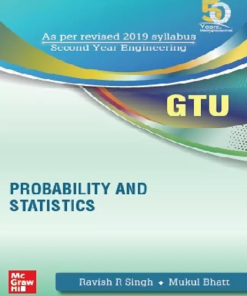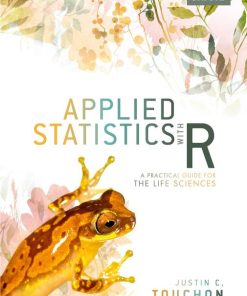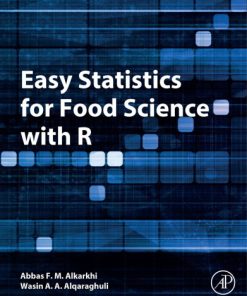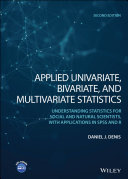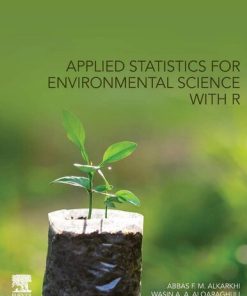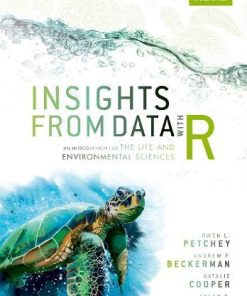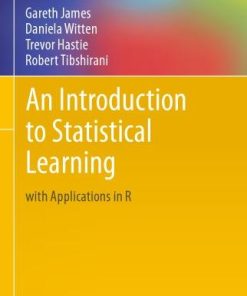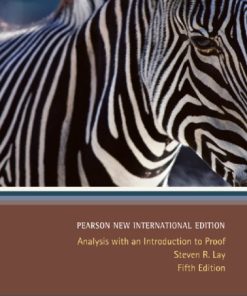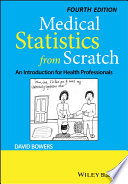The New Statistics with R An Introduction for Biologists 2nd Edition by Andy Hector 0192519177 9780192519177
$50.00 Original price was: $50.00.$25.00Current price is: $25.00.
The New Statistics with R: An Introduction for Biologists 2nd Edition by Andy Hector – Ebook PDF Instant Download/DeliveryISBN: 0192519177, 9780192519177
Full download The New Statistics with R: An Introduction for Biologists 2nd Edition after payment.

Product details:
ISBN-10 : 0192519177
ISBN-13 : 9780192519177
Author: Andy Hector
Statistical methods are a key tool for all scientists working with data, but learning the basics continues to challenge successive generations of students. This accessible textbook provides an up-to-date introduction to the classical techniques and modern extensions of linear model analysis-one of the most useful approaches for investigating scientific data in the life and environmental sciences. While some of the foundational analyses (e.g. t tests, regression, ANOVA) are as useful now as ever, best practice moves on and there are many new general developments that offer great potential. The book emphasizes an estimation-based approach that takes account of recent criticisms of over-use of probability values and introduces the alternative approach that uses information criteria. This new edition includes the latest advances in R and related software and has been thoroughly “road-tested” over the last decade to create a proven textbook that teaches linear and generalized linear model analysis to students of ecology, evolution, and environmental studies (including worked analyses of data sets relevant to all three disciplines). While R is used throughout, the focus remains firmly on statistical analysis. The New Statistics with R is suitable for senior undergraduate and graduate students, professional researchers, and practitioners in the fields of ecology, evolution and environmental studies.
The New Statistics with R: An Introduction for Biologists 2nd Table of contents:
1: Introduction
1.1 Introduction to the second edition
1.2 The aim of this book
1.3 Changes in the second edition
1.4 The R programming language for statistics and graphics
1.5 Scope
1.6 What is not covered
1.7 The approach
1.8 The new statistics?
1.9 Getting started
1.10 References
2: Motivation
2.1 A matter of life and death
2.2 Summary: Statistics
2.3 Summary: R
2.4 References
3: Description
3.1 Introduction
3.1.1 r packages
3.2 Darwin’s maize pollination data
3.2.1 know your data
3.2.2 summarizing and describing data
3.2.3 comparing groups
3.3 Summary: Statistics
3.4 Summary: R
3.5 References
4: Reproducible Research
4.1 The reproducibility crisis
4.1.1 R packages
4.2 R scripts
4.3 Analysis notebooks
4.4 R Markdown
4.5 Summary: Statistics
4.6 Summary: R
4.7 References
5: Estimation
5.1 Introduction
5.1.1 R Packages
5.2 Quick tests
5.3 Differences between groups
5.4 Standard deviations and standard errors
5.5 The normal distribution and the central limit theorem
5.6 Confidence intervals
5.7 Summary: Statistics
5.8 Summary: R
Appendix 5a: R code for Fig. 5.1
6: Linear Models
6.1 Introduction
6.1.1 R Packages
6.2 A linear-model analysis for comparing groups
6.3 Standard error of the difference
6.4 Confidence intervals
6.5 Answering Darwin’s question
6.6 Relevelling to get the other treatment mean and standard error
6.7 Assumption checking
6.7.1 Normality
6.7.2 Equal Variance
6.8 Summary: Statistics
6.9 Summary: R
6.10 Reference
Appendix 6a: R graphics
Appendix 6b: Robust linear models
Appendix 6c: Exercise
7: Regression
7.1 Introduction
7.1.1 R Packages
7.2 Linear regression
7.3 The Janka timber hardness data
7.4 Correlation
7.5 Linear regression in R
7.6 Assumptions
7.7 Summary: Statistics
7.8 Summary: R
7.9 Reference
Appendix 7a: R graphics
Appendix 7b: Least squares linear regression
8: Prediction
8.1 Introduction
8.1.1 R Packages
8.2 Predicting timber hardness from wood density
8.3 Confidence intervals and prediction intervals
8.4 Summary: Statistics
8.5 Summary: R
9: Testing
9.1 Significance testing: Time for t
9.1.1 R Packages
9.2 Student’s t-test: Darwin’s maize
9.3 Summary: Statistics
9.4 Summary: R
9.5 References
10: Intervals
10.1 Comparisons using estimates and intervals
10.1.1 R Packages
10.2 Estimation-based analysis
10.3 Descriptive statistics
10.3.1 Error Bars
10.3.2 Standard-deviation Error Bars
10.4 Inferential statistics
10.4.1 Standard Error Bars
10.4.2 Confidence Intervals
10.4.3 Confidence Intervals For Differences Between Means
10.4.4 Least Significant Differences
10.4.5 Multi-interval Plots
10.4.6 Prediction Intervals
10.5 Relating different types of interval and error bar
10.5.1 Interpreting Confidence Intervals
10.5.2 Point Estimates And Confidence Intervals For Research Synthesis And Meta-analysis
10.6 Summary: Statistics
10.7 Summary: R
10.8 References
11: Analysis of Variance
11.1 ANOVA tables
11.1.1 R packages
11.2 ANOVA tables: Darwin’s maize
11.3 Hypothesis testing: F-values
11.4 Two-way ANOVA
11.5 Summary
11.6 Reference
12: Factorial Designs
12.1 Introduction
12.1.1 R Packages
12.2 Factorial designs
12.3 Comparing three or more groups
12.4 Two-way ANOVA (no interaction)
12.5 Additive treatment effects
12.6 Interactions: Factorial ANOVA
12.6.1 Factorial Anova In R
12.7 Summary: Statistics
12.8 Summary: R
12.9 References
Appendix 12a: Code for Fig. 12.3
13: Analysis of Covariance
13.1 ANCOVA
13.1.1 R Packages
13.2 The agricultural pollution data
13.2.1 Warning: R Regenerates!
13.3 ANCOVA with water stress and low-level ozone
13.4 Interactions in ANCOVA
13.5 General linear models
13.6 Summary
13.7 References
14: Linear Model Complexities
14.1 Introduction
14.2 Analysis of variance for balanced designs
14.3 Analysis of variance with unbalanced designs
14.4 ANOVA tables versus coefficients: When F and t can disagree
14.5 Marginality of main effects and interactions
14.6 Summary
14.7 References
15: Generalized Linear Models
15.1 GLMs
15.2 The trouble with transformations
15.3 The Box–Cox power transform
15.4 Generalized Linear Models in R
15.5 Summary: Statistics
15.6 Summary: R
15.7 References
16: GLMs for Count Data
16.1 Introduction
16.2 GLMs for count data
16.3 Quasi-maximum likelihood
16.4 Summary
17: Binomial GLMs
17.1 Binomial counts and proportion data
17.2 The beetle data
17.3 GLM for binomial counts
17.4 Alternative link functions
17.5 Summary: Statistics
17.6 Summary: R
17.7 Reference
18: GLMs for Binary Data
18.1 Binary data
18.1.1 R Packages
18.2 The wells data set for the binary GLM example
18.3 Centering
18.4 Summary
18.5 References
19: Conclusions
19.1 Introduction
19.2 A binomial GLM analysis of the Challenger binary data
19.3 Recommendations
19.4 Where next?
19.5 Further reading
19.6 The R café
19.7 References
20: A Very Short Introduction to R
20.1 Installing R
20.2 Installing RStudio
20.3 R packages
20.4 The R language
20.4.1 Functions
20.4.2 Arguments
20.4.3 Objects
20.4.4 Dataframes
20.4.5 Graphics
People also search for The New Statistics with R: An Introduction for Biologists 2nd:
introduction to the new statistics
introduction to the new statistics pdf
understanding the new statistics
one reason for the shift to the new statistics is
resampling the new statistics
Tags: The New Statistics, Introduction, Biologists, Andy Hector
You may also like…
Mathematics - Mathematical Statistics
Mathematics - Mathematical Statistics
Applied Statistics with R: A Practical Guide for the Life Sciences
Computers - Programming
Easy Statistics for Food Science with R 1st Edition Abdulraheem Alqaraghuli
Mathematics - Mathematical Statistics
Computers - Applications & Software
Applied Statistics for Environmental Science With R 1st Edition
Mathematics - Mathematical Statistics
Insights from Data with R: An Introduction for the Life and Environmental Sciences 1st Edition
Mathematics - Analysis
Analysis with an Introduction to Proof: Pearson New International Edition 5th Edition Steven R. Lay
Medicine - Medicine & Nursing Reference
Medical Statistics From Scratch: An Introduction for Health Professionals 4th Edition


